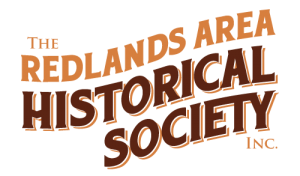2014 HERITAGE AWARD RECIPIENT
The Redlands Area Historical Society, Inc.
Heritage Award 2014
Harold and Emma Anderson Residence
204 East Olive Avenue
1920
Thomas and Herbert Yerxa co-owners of Spoor and Yerxa, motor car dealers, contracted for $3500 to construct both 204 and 208 East Olive Avenue in 1920. They also pulled a permit for a $1500 addition to the Lee Wilmarth home. Spoor and Yerxa were distributors for Star, Durant, and Packard motor cars. They built homes as a side line business in the Roaring 1920s.
Harold W. Anderson and his wife Emma were the first to move into the home. Anderson was foreman of the Anderson Diamond Irrigation Flume Gate Company. Martin Anderson, inventor and manufacturer of the flume gate began production in 1895. Anderson was a concrete contractor and very much involved in pouring concrete flumes. His flume gate replaced the wood-hole irrigation system and allowed the farmer to regulate flow down a citrus furrow. Martin died in 1925 leaving the business to his son, Harold. This business flourished in Redlands.
In both 1925 and 1933 the City Directories show the home as vacant. In 1929, Lulu L. Coggeshall lived here. Beginning in 1936, Chris and Flora Woodside rented the home. Maxine and William Boling replaced the incinerator for $20 in 1940. Morning trash fires polluted Redlands until the city took on trash removal. Arth E. Andersen and Beverly Cline are shown as residents in 1941. Wilbur Ralston did roof repair and electrical work in 1947 and 1950.
George H. Mayer and his wife, Amy Lee became the retired owners in 1951. Howard Keenor did additional plumbing to replace the 1920 water heater in 1971. To the end of the century the home continued to decline and was near demolition when it was purchased by Dr. Conrad Lucero.
This home became an Adaptive Re-use structure beginning in 1999 through the efforts of Dr. Conrad Lucero. Permits on file with the city document a complete renovation to the foundation, walls, electrical, heating, air conditioning, and an extension of the home. The plans were approved with a Certificate of Appropriateness from the Historic and Scenic Preservation Commission and the residence/office became Historic Resource #98 for the City of Redlands.
The Craftsman Bungalow retains is original front porch. A low pitched roof with protruding rafters and decorative brackets speak well for the period. The foundation, fire place chimney, and pier porch supports are all concrete and cobble-stone design. Two different types of porch columns are present: Doric columns and truncated columns are employed from the cobble stone piers to the roof line. The back addition matches the shiplap siding throughout the exterior of the home. Attic vents are slats of wood to allow for good ventilation. Dr. Lucero even built a matching irrigation box of shiplap siding.
This home and now dentist office retains the original Craftsman Bungalow textures from the street. Yet, the interior is a modern dentist office with a wide hallway, large windows and thoroughly insulated structure. Adaptive Re-use is really given a good name with fine work such as this. The Redlands Area Historical Society wants Dr. Conrad Lucero to know that we appreciate his vision and award him a 2014 Heritage Award.
Research by: Tom Atchley
Presented
16 June 2014


